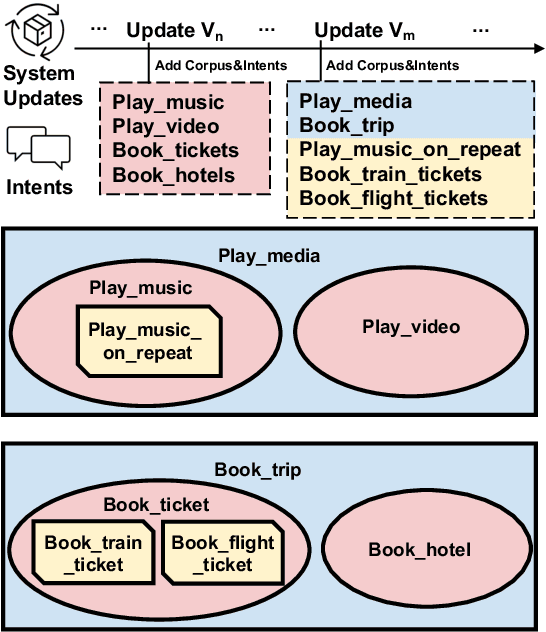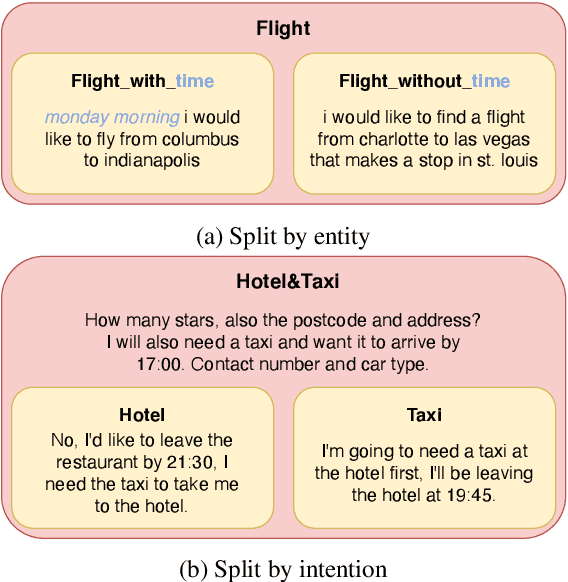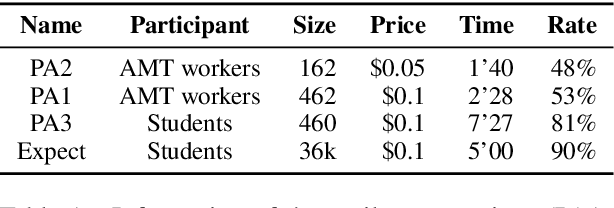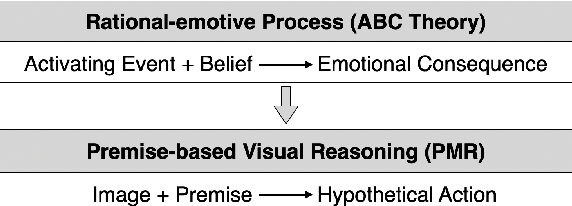Haoran Meng
DialogVCS: Robust Natural Language Understanding in Dialogue System Upgrade
May 24, 2023



Abstract:In the constant updates of the product dialogue systems, we need to retrain the natural language understanding (NLU) model as new data from the real users would be merged into the existent data accumulated in the last updates. Within the newly added data, new intents would emerge and might have semantic entanglement with the existing intents, e.g. new intents that are semantically too specific or generic are actually subset or superset of some existing intents in the semantic space, thus impairing the robustness of the NLU model. As the first attempt to solve this problem, we setup a new benchmark consisting of 4 Dialogue Version Control dataSets (DialogVCS). We formulate the intent detection with imperfect data in the system update as a multi-label classification task with positive but unlabeled intents, which asks the models to recognize all the proper intents, including the ones with semantic entanglement, in the inference. We also propose comprehensive baseline models and conduct in-depth analyses for the benchmark, showing that the semantically entangled intents can be effectively recognized with an automatic workflow.
DialogQAE: N-to-N Question Answer Pair Extraction from Customer Service Chatlog
Dec 14, 2022



Abstract:Harvesting question-answer (QA) pairs from customer service chatlog in the wild is an efficient way to enrich the knowledge base for customer service chatbots in the cold start or continuous integration scenarios. Prior work attempts to obtain 1-to-1 QA pairs from growing customer service chatlog, which fails to integrate the incomplete utterances from the dialog context for composite QA retrieval. In this paper, we propose N-to-N QA extraction task in which the derived questions and corresponding answers might be separated across different utterances. We introduce a suite of generative/discriminative tagging based methods with end-to-end and two-stage variants that perform well on 5 customer service datasets and for the first time setup a benchmark for N-to-N DialogQAE with utterance and session level evaluation metrics. With a deep dive into extracted QA pairs, we find that the relations between and inside the QA pairs can be indicators to analyze the dialogue structure, e.g. information seeking, clarification, barge-in and elaboration. We also show that the proposed models can adapt to different domains and languages, and reduce the labor cost of knowledge accumulation in the real-world product dialogue platform.
DialogUSR: Complex Dialogue Utterance Splitting and Reformulation for Multiple Intent Detection
Oct 20, 2022



Abstract:While interacting with chatbots, users may elicit multiple intents in a single dialogue utterance. Instead of training a dedicated multi-intent detection model, we propose DialogUSR, a dialogue utterance splitting and reformulation task that first splits multi-intent user query into several single-intent sub-queries and then recovers all the coreferred and omitted information in the sub-queries. DialogUSR can serve as a plug-in and domain-agnostic module that empowers the multi-intent detection for the deployed chatbots with minimal efforts. We collect a high-quality naturally occurring dataset that covers 23 domains with a multi-step crowd-souring procedure. To benchmark the proposed dataset, we propose multiple action-based generative models that involve end-to-end and two-stage training, and conduct in-depth analyses on the pros and cons of the proposed baselines.
Premise-based Multimodal Reasoning: A Human-like Cognitive Process
May 15, 2021



Abstract:Reasoning is one of the major challenges of Human-like AI and has recently attracted intensive attention from natural language processing (NLP) researchers. However, cross-modal reasoning needs further research. For cross-modal reasoning, we observe that most methods fall into shallow feature matching without in-depth human-like reasoning.The reason lies in that existing cross-modal tasks directly ask questions for a image. However, human reasoning in real scenes is often made under specific background information, a process that is studied by the ABC theory in social psychology. We propose a shared task named "Premise-based Multimodal Reasoning" (PMR), which requires participating models to reason after establishing a profound understanding of background information. We believe that the proposed PMR would contribute to and help shed a light on human-like in-depth reasoning.
 Add to Chrome
Add to Chrome Add to Firefox
Add to Firefox Add to Edge
Add to Edge